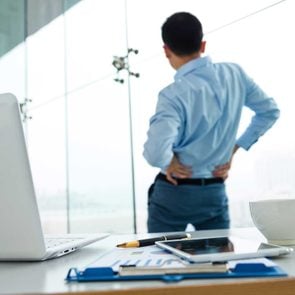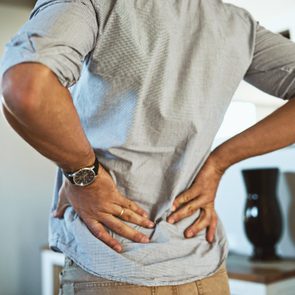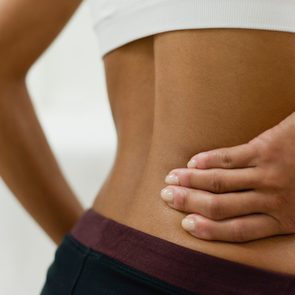What Causes Lower Back Pain in Women?
Updated: Mar. 11, 2022
Low back pain strikes both genders equally, but there are causes that specifically affect women, ranging from pregnancy to endometriosis.
Causes of lower back pain in women
If your monthly period brings on either dull or sharp low back pain, you’re not alone.
Although back pain affects both sexes equally, women may be more prone to experience back pain related to hormonal changes throughout life, including menstruation and pregnancy.
There are many structures in and around your lower back—including muscles, soft connective tissue, ligaments, blood vessels, nerves, joints, discs, and bone—that can cause or worsen pain. In women, reproductive organs are also on the list.
Depending on the cause, lower back pain can last weeks or months. It can be dull or sharp and is sometimes accompanied by numbness, weakness, or pain that can radiate to other parts of the body like your buttocks or legs. You may be more likely to experience back pain if you are overweight or obese, smoke, or lead a sedentary lifestyle.
Both sexes can experience lower back pain brought on by overexertion, a fall (even a minor one), excess weight, improper lifting, or psychological stress, among other possibilities.
“Most causes of lower back do not discriminate; however, women may have more lower back pain related to hormonal imbalance, menstruation, or around menopause,” says Yili Huang, DO, a licensed and board-certified pain management anesthesiologist and director of the Pain Management Center, Northwell Health’s Phelps Hospital, in Sleepy Hollow, New York.
(Here are more surprising reasons for back pain.)
We spoke with pain experts to further understand the specific causes of lower back pain in women, as well as symptoms, treatments, and when you should see a doctor.
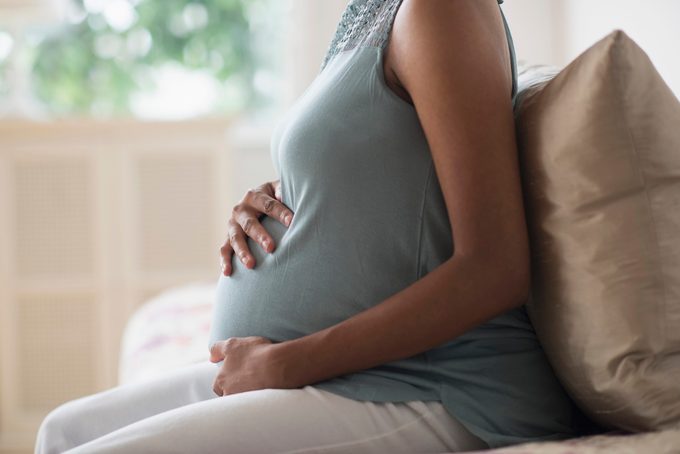 Pregnancy
Pregnancy
“During pregnancy, there is a shift in the weight one carries and the location of where that weight is carried,” says Rahul Shah, MD, a spine and neck surgeon with offices across New Jersey.
The muscles and ligaments have to adapt to that new location of weight depending on how the baby sits,” Dr. Shah says. “When the body is adjusting to where the weight is, some women may experience additional pain.”
Hormonal and mechanical changes during pregnancy and labor can also lead to sacroiliac joint dysfunction, says Dr. Huang. The sacroiliac joint connects the pelvis to the lower spine. “This is one common cause of lower back pain for women who have been pregnant,” he explains.
Symptoms
Backaches are one of the most common pregnancy complaints, especially in the later months of pregnancy. This pain may radiate down the back of the leg—what’s called sciatica. Sciatica is pain from the sciatic nerve which runs down the lower back, buttocks, and back of the leg, even into the feet.
Diagnosis and treatment
If you are pregnant and experiencing back pain, it is likely due to the extra weight you are carrying. Treatment for pregnancy-related back pain includes wearing supportive clothing like maternity belts or bands, and using heat or cold to soothe your aches. Ask your ob-gyn what else can safely help reduce back pain during pregnancy.
(Here are some pregnancy myths you can ignore.)
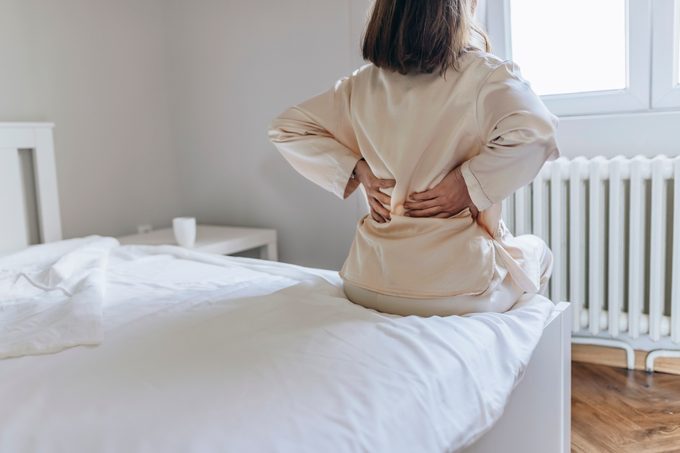 Menopause
Menopause
During menopause, there is a dramatic drop in the female sex hormone estrogen, and this affects everything from your hair and skin to your mood, bones, and heart.
“Postmenopausal hormonal changes predispose women to weakened bones, [a condition] called osteoporosis, and this can lead to more fractures of the spine, which can cause severe back pain,” says Dr. Huang.
Symptoms
If you are in menopause, which starts one full year after your last menstrual cycle, your risk for developing the brittle bone disease osteoporosis increases due to the lack of estrogen. Brittle bones are more likely to crack, and osteoporosis-related spinal fractures affect nearly 700,000 people each year, according to the American Academy of Orthopedic Surgeons.
“A byproduct of such changes includes loss of bone density,” says Dr. Shah. “This can serve to weaken bones, especially the spinal vertebrae (or back bones). This can lead to an increased risk of spinal fractures. These fractures can be quite painful when they occur.”
Diagnosis and treatment
Your doctor can identify fractures with X-rays or other imaging tests. Bone density testing can diagnosis any issues and help determine whether you need to take medication to help keep your bones strong. Pain medication, bracing, and physical therapy can help reduce fracture-related pain.
(Find out more about using a brace for lower back pain.)
Sometimes a minimally invasive procedure known as kyphoplasty—where your doctor makes space in your vertebrae with a balloon-like device and fills the space with special bone cement to restore height and reduce pain—can help. Surgery is usually the last resort for spinal fractures.
PMS
Premenstrual syndrome (PMS) refers to a combination of symptoms that may occur in a week or two before your period.
Many women develop lower back pain before their monthly period, says Nikhil Jain, MD, a fellow in the department of neurosurgery at the University of Louisville in Kentucky. Exactly why this occurs is not fully understood, but it is likely related to hormonal changes leading to menstruation. (Here’s how to get menstrual cramps relief.)
Symptoms
In addition to lower back pain, PMS also can cause bloating, headaches, and moodiness.
Treatment and diagnosis
Because these symptoms are directly tied to menstruation, they likely occur at the same time each month, making it relatively easy for your doctor to pinpoint the cause. Keeping a PMS symptom diary for a few months also can help connect the dots. If your PMS is severe, medications are available to help lessen your symptoms.
Regular exercise and getting good-quality sleep can help relieve PMS symptoms. Avoiding foods and drinks with caffeine, salt, and sugar in the two weeks leading up to your period has also been shown to ease some symptoms.
PMDD
Premenstrual dysmorphic disorder (PMDD) is more severe than PMS and has more intense and debilitating symptoms. (Here’s how to tell if your PMS symptoms are actually PMDD symptoms.)
As with PMS, researchers are not 100 percent sure what causes PMDD, but the theory is that your brain has an abnormal reaction to the hormone changes, which leads to some of the symptoms.
Symptoms
PMDD can cause low back pain as well as severe irritability, depression, or anxiety in the week or two before your period.
Diagnosis and treatment
Keeping a symptom diary can help determine whether you have PMDD. The good news is that there are treatments available, including antidepressants, that are specifically approved to treat PMDD. Certain birth control pills also can help. In addition, over-the-counter pain medications may relieve some of the physical symptoms such as back pain.
Your doctor may also suggest relaxation techniques that lower your stress levels, such as mindfulness or meditation.
Endometriosis
Endometriosis occurs when tissue that is similar to the uterine lining grows outside of your uterus. “This causes bleeding, swelling, and inflammation in the pelvic cavity during the menstrual cycle,” says Dr. Jain.
Symptoms
Endometriosis can cause pain in many areas, including your lower back. You may also have painful cramping during your period, pain during or after sex, and sometimes pain during urination.
Diagnosis and treatment
Your gynecologist can diagnose this condition by asking you questions about your menstrual cycle and premenstrual symptoms and conducting a pelvic exam to feel for endometrial patches. Sometimes imaging tests are needed to get a better picture of what is going on.
If you are not trying to get pregnant, hormonal birth control can help ease the pain of endometriosis. Over-the-counter medicines for pain, such as ibuprofen, may also help.
In some cases, laparoscopic surgery is needed to remove the abnormal patches and scar tissue, which may help ease pain and other symptoms, at least temporarily.
Dysmenorrhea
Dysmenorrhea is the medical name for painful periods.
Most women will have some discomfort during their period, but for others, the pain can be more intense and affect their lower back.
Dysmenorrhea occurs when your uterus contracts to help the uterine lining leave your body. It may also be related to other health problems such as endometriosis. That’s a condition when tissue similar to the type found in the uterine lining grows other places in the body.
Women with uterine fibroids—non-cancerous growths in the wall of the uterus—may be more likely to have low back pain and cramping during mensturation, Dr. Jain says.
Symptoms
You may experience cramps in your lower abdomen, low back pain, nausea, vomiting, diarrhea, fatigue, weakness, fainting, or headaches if you have dysmenorrhea.
Diagnosis and treatment
Keep a symptom diary so you are aware of when symptoms occur in your menstrual cycle. Oral contraceptives can help lighten your flow, which should improve symptoms of heavy periods. For many women, non-steroidal anti-inflammatory drugs (NSAIDs) along with heating pads can take the edge off of period pain. (These yoga poses may help low back pain.)
Heart health
There are times when back pain may be a sign of heart attack in women. Your risk of heart attack is increased if you have high blood pressure, diabetes, high cholesterol, or are obese.
Symptoms
Other signs of heart attack in women may include fatigue, chest pain or pressure, nausea, or light-headedness.
Diagnosis and treatment
Know the signs of heart attack and seek help immediately should they occur. Get to the nearest emergency room or call 911 so you can be evaluated and treated, if necessary.
Other types of lower back pain
Lower back pain from muscle spasms, slipped discs, infection, osteoarthritis (the wear and tear from the disease), or spinal stenosis (a narrowing of your spine that puts pressure on your nerves and spinal cord) doesn’t discriminate. In these cases, the diagnosis and treatment don’t differ much by sex, says Dr. Shah.
“By and large, when someone comes to my office, we just know if their back hurts and if there is pain that is going to other areas like the buttocks or leg,” he says. “With such complaints, we begin with a physical examination and then order a variety of additional imaging tests.”
Here are a few other common causes among both sexes:
Muscle spasms
These are painful twinges in your lower back.
Muscle spasms in your back can occur as a result of exercise, dehydration, stress, repeated heavy lifting, or even a sudden awkward twist or turn, explains Jake Magel, PhD, physical therapist and research assistant professor, University of Utah, Salt Lake City.
Symptoms
Spasms come on fast and furious and may even twitch. Muscle spasms tend to come and go.
Diagnosis and treatment
Your doctor will ask you questions about your pain and when it tends to occur, and may order imaging tests as well. In general, staying active, taking NSAIDs such as ibuprofen or naproxen, and participating in physical therapy can usually help muscle spasms. Heating pads can help relax muscle spasms.
Slipped discs
Your lower back comprises five vertebrae (L1-L5) that support your upper body, and shock-absorbing discs are found between each vertebra that can slip, tear, shift, or degenerate.
Poor posture, heavy lifting, twisting, bending, an injury, a fall, or advancing age can all cause your discs to slip or change, says Dr. Jain.
Symptoms
A problematic disc can cause back pain as well as sciatica if it presses on your nerves.
Diagnosis and treatment
Your doctor will likely send you for imaging tests of your lower back to see if your discs have slipped or herniated and are responsible for your back pain, Dr. Jain says. Treatment usually involves pain medications and/or physical therapy. Sometimes more serious treatment is needed, including steroid injections or surgery, Dr. Jain says. (Learn how one woman with a herniated disc healed with mind-body exercises.)
Osteoarthritis
The wear and tear form of arthritis, osteoarthritis (OA), can strike any joint in your body. The risk of developing OA increases as you age. Extra weight and pressure on your joints can also lead to OA.
Symptoms
OA is marked by pain in the joints, especially during activity. The pain occurs when the smooth cushion between your bones (cartilage) breaks down.
Diagnosis and treatment
Your doctor will ask you questions about your back pain, perform a physical exam, and order some imaging tests to see what is going on. Physical therapy and pain medications are first-line treatments for arthritis, but sometimes steroid injections or possibly joint replacement surgery may be warranted, Jain says.
Spinal stenosis
This condition occurs when the space around your spinal cord narrows and puts pressure on the cord and your spinal nerves.
Advancing age is the main risk for spinal stenosis. It is most common in people older than 60.
Symptoms
Spinal stenosis doesn’t always cause pain or other symptoms, but it can. This condition may cause numbness and irritate your nerves, causing hip pain in addition to back pain. (These are the everyday habits that are damaging your spine.)
Diagnosis and treatment
Your doctor will feel your back and may ask you to bend forward, backward, or side to side. Imaging tests are also needed to diagnose spinal stenosis. Treatment typically includes physical therapy and NSAIDs, followed by steroid injections if NSAIDs don’t do the trick. Surgery is a last resort.
Infection
There are several types of infection that can lead to back pain, but the most common is vertebral osteomyelitis, or an infection in a bone that causes inflammation.
You may develop an infection in your back from trauma to your spine or it may migrate from another area in your body to your back.
Symptoms
In addition to pain, an infection may also cause fever, and there will be redness and tenderness in the infected area.
Diagnosis and treatment
Your doctor may run blood tests or conduct imaging tests to help diagnose a spinal infection. Treatment involves antibiotics, which are administered at the hospital. There are times when surgery is needed to treat an infection in your back. (These are signs that your back pain is an emergency.)
Lifestyle interventions for low back pain
Maintaining a healthy weight, not smoking, or quitting if you do smoke, can help reduce your chances of developing back pain. Getting regular exercise also can keep muscles—including those that support your back—strong throughout your life, says Magel. (Try these exercises for lower back pain.)
Often over-the-counter pain relievers such as aspirin, acetaminophen, or NSAIDs can help reduce back pain and any swelling in the area. Heating pads and ice packs can also help relieve some types of lower back pain. Certain stretches for lower back pain can help prevent or relieve it too. These foam-rolling exercises may help alleviate pain and soreness.
Finding the most comfortable sleep position for back pain can also make a difference, especially because sleep loss makes back pain worse. (Find the best sleeping position for your low back pain.)
Another component is lumbar or low back support. The American Academy of Family Physicians suggests sitting in chairs with straight backs or low back support, and keeping your knees a little higher than your hips. Consider placing a small pillow or rolled-up towel behind your lower back if driving or sitting for a long time.
The last word
For the most part, low back pain is an equal opportunity offender. However, hormonal changes associated with pregnancy, menopause, and even menstruation can cause low back pain in women. Discuss your symptoms with your doctor to find out the best ways to relieve your low back pain. If you are in or approaching menopause, get your bone density tested and try to keep your bones strong and stave off painful spinal fractures.



















